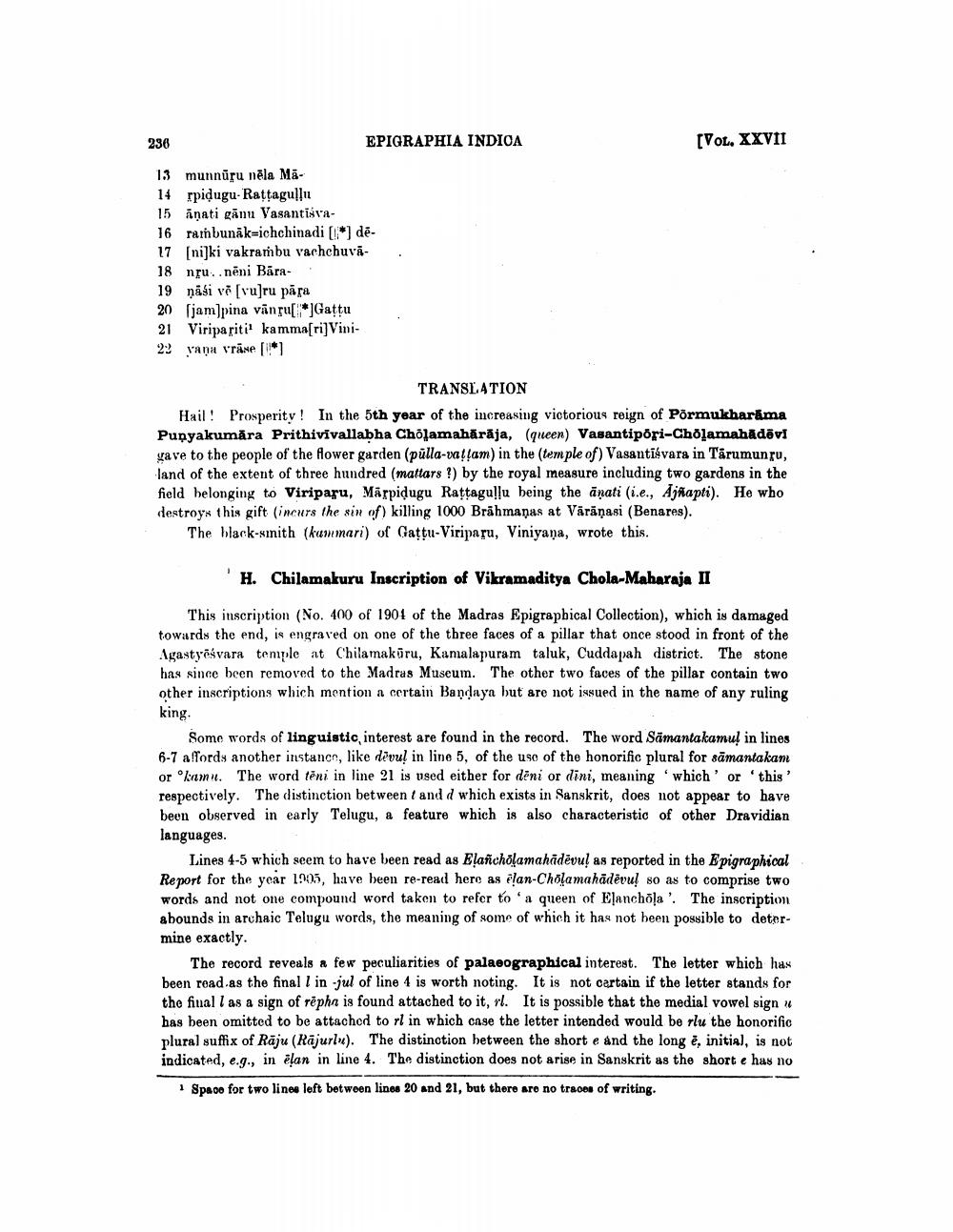________________
236
EPIGRAPHIA INDICA
[Vol. XXVII
.
13 munnūru nēla Ma14 rpidugu-Rattagu!ļu 15 anati gānu Vasantista16 rambunāk=ichchinadi (1*] de17 [ni]ki vakraṁbu vachchuva- 18 nu.. nēni Bāra19 ņåsi vě [vu]ru pāça 20 sjampina vānpu[*]Gattu 21 Viriparitit kamma[ri]Vini29 yana vrane [*]
TRANSLATION Hail! Prosperity! In the 5th year of the increasing victorious reign of Pörmukharima Punyakumara Prithivivallabha Cholamahārāja, (queen) Vasantipori-Chlamahadēvi yave to the people of the flower garden (pūlla-vatļam) in the temple of) Vasantīśvara in Târumungu, land of the extent of three hundred (mattars?) by the royal measure including two gardens in the field belonging to Viriparu, Märpidugu Raţtagul!u being the anati (i.e., Ajñapti). He who destroys this gift (incurs the sin of killing 1000 Brahmanas at Väränasi (Benares).
The black-sinith (kammari) of Gattu-Viriparu, Viniyama, wrote this.
H. Chilamakuru Inscription of Vikramaditya Chola-Maharaja II
This inscription (No. 400 of 1901 of the Madras Epigraphical Collection), which is damaged towards the end, is engraved on one of the three faces of a pillar that once stood in front of the Agastyasvara temple at Chilamakuru, Kamalapuram taluk, Cuddapah district. The stone has since been removed to the Madras Museum. The other two faces of the pillar contain two other inscriptions which mention a certain Bandaya but are not issued in the name of any ruling king.
Some words of linguistic interest are found in the record. The word Sämantakamul in lines 6-7 aflords another instance, like devul in line 5, of the uso of the honorific plural for sāmantakam or kamu. The word tēni in line 21 is used either for deni or dini, meaning which' or this respectively. The distinction between t and d which exists in Sanskrit, does not appear to have been observed in early Telugu, a feature which is also characteristic of other Dravidian languages.
Lines 4-5 which seem to have been read as Elañchõlamahädēvul as reported in the Epigraphical Report for the year 1905, have been re-read here as elan-Cholamahādēvu! so as to comprise two words and not one compound word taken to refer to a queen of Elancho!a!. The inscription abounds in archaic Telugu words, the meaning of some of which it has not been possible to determine exactly.
The record reveals a few peculiarities of palaeographical interest. The letter which has been read as the final l in jul of line 4 is worth noting. It is not certain if the letter stands for the final las a sign of répha is found attached to it, rl. It is possible that the medial vowel signu has been omitted to be attached to rl in which case the letter intended would be rlu the honorific plural suffix of Rāju (Rājurlu). The distinction between the short e and the long e, initial, is not indicated, e.g., in ēlan in line 4. The distinction does not arise in Sanskrit as the short e has no
1 Space for two linee left between lines 20 and 21, but there are no traces of writing.




